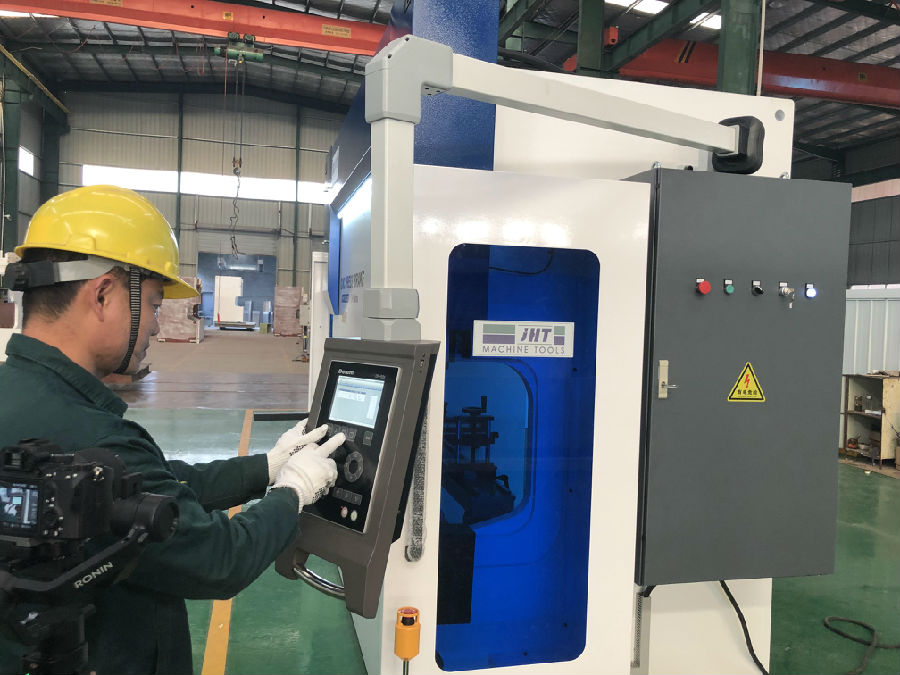Press brake safety operation rules
1. Strictly abide by the safety operation rules of machine tool workers, and wear labor protection equipment as required.
2. Before starting, it is necessary to carefully check whether the motor, switch, circuit and grounding are normal and firm, and check that the operating parts and buttons of the equipment are in the correct position.
3. Check the coincidence and firmness of the upper and lower molds; check whether each positioning device meets the requirements of being processed.
4. When the upper slide plate and each positioning axis are not at the origin, run the back-to-origin program.
5. After the equipment is started, it should run idly for 1-2 minutes, and the upper sliding plate will move 2-3 times in full stroke. If any abnormal sound or fault is found, it should be stopped immediately, and the fault should be eliminated, and it can work only after everything is normal.
6. When working, one person should be under the unified command, so that the operator and the feeding and pressing personnel are closely coordinated to ensure that all the cooperating personnel are in a safe position to send the bending signal.
7. When the sheet is bent, it must be compacted to prevent the sheet from lifting and hurting people during bending.
8. The power supply must be cut off when the plate material is pressed, and the operation must be stopped.
9. When changing the opening of the variable die, no material is allowed to come into contact with the die.
10. When the machine tool is working, no one is allowed to stand behind the machine tool.
11. It is strictly forbidden to fold the sheet at one end alone.
12. If the workpiece or mold is found to be incorrect during operation, it should be stopped for correction. It is strictly forbidden to correct by hand during operation to prevent hand injury.
13. It is forbidden to fold ultra-thick iron plates or quenched steel plates, high-grade alloy steels, square steels and plates that exceed the performance of the plate bending machine, so as not to damage the machine tool.
14. Always check the coincidence of the upper and lower molds; whether the indication of the pressure gauge meets the regulations.
15. Immediately shut down when an abnormality occurs, check the cause and eliminate it in time.
16. Before shutting down, place a wooden block on the lower die under the oil cylinders on both sides and lower the upper sliding plate to the wooden block.
17. Exit the control system program first, and then cut off the power.
[edit this paragraph]
press brake maintenance and maintenance
Before maintenance or cleaning of the machine tool, the upper die should be aligned with the lower die, then put down and shut down until the work is completed. If you need to start the machine or other operations, you should select the manual mode and ensure safety. Its maintenance content is as follows:
1. Hydraulic oil circuit
a. Check the oil level of the fuel tank every week. If the hydraulic system is repaired, it should also be checked. The oil level should be filled with hydraulic oil if the oil level is lower than the oil window;
b. The hydraulic oil used in this machine is ISO HM46 or MOBIL DTE25;
c. The oil should be changed after the new machine works for 2000 hours, the oil should be changed after every 4000-6000 hours of operation, and the oil tank should be cleaned every time the oil is changed;
d. The oil temperature of the system should be between 35°C and 60°C, and should not exceed 70°C. If it is too high, the oil quality and accessories will be deteriorated and damaged.
2. Filter
a. Every time the oil is changed, the filter should be replaced or thoroughly cleaned;
b. The machine tool has related alarms or the oil quality is not clean and other filters are abnormal and should be replaced;
c. The air filter on the fuel tank should be checked and cleaned every 3 months, preferably every 1 year.
3. Hydraulic components
a. Clean hydraulic components (substrates, valves, motors, pumps, oil pipes, etc.) monthly to prevent dirt from entering the system, and do not use detergents;
b. After the new machine is used for one month, check whether the bending of each oil pipe is deformed. If there is any abnormality, it should be replaced. After two months of use, the connections of all accessories should be tightened. When this work is performed, the system should be turned off. pressure
[edit this paragraph]
Hydraulic Press brake machine Structure and features
1. It adopts all-steel welded structure with sufficient strength and rigidity.
2. Hydraulic upper transmission, the oil cylinders at both ends of the machine tool are placed on the slider to directly drive the sliding work.
3. The slider synchronization mechanism adopts torsion shaft forced synchronization.
4. It adopts mechanical block structure, which is stable and reliable.
5. The slider stroke is motorized and quickly adjusted, manual fine-tuning, and counter display.
6. Wedge-type deflection compensation mechanism to ensure high bending accuracy.
The press brake includes a bracket, a worktable and a clamping plate. The worktable is placed on the bracket. The worktable is composed of a base and a pressure plate. The base is connected to the clamping plate by a hinge. The base is composed of a seat shell, a coil and a cover plate. Inside the recess of the seat shell, the top of the recess is covered with a cover plate.
When in use, the coil is energized by the wire, and after the electricity is energized, the pressure plate is gravitationalized, so as to realize the clamping of the thin plate between the pressure plate and the base. Due to the use of electromagnetic force clamping, the pressing plate can be made into various workpiece requirements, and the workpiece with side walls can be processed.

